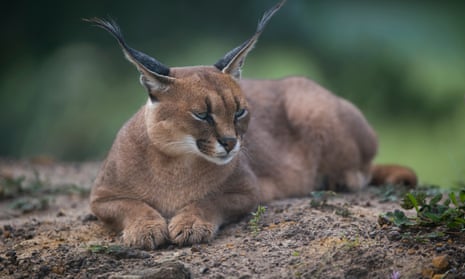The big-cat house at the Ménagerie du Jardin des Plantes in Paris is the focus of Pascale Petit’s new collection, Fauverie.
Previewing the collection on her blog last year, Petit explained that the word “fauverie” also conjures “a ‘fauve’ wild beast painting, a habitat of primal colour and encagement”. This week’s poem, Caracal, comes late in the collection and forms a moment of reflection, a cool breathing space, where quiet earth colours predominate and match the elegiac tone.
The caracal (also known as the desert lynx) has a coat of “fawn-rust” that resembles the “sandy loam” of Papa’s grave. When Black Ears leaps for his steak in the third tercet “it’s like a desert doing a somersault”. The bold synthesis of the animal’s natural absence of markings and the curiously “unmarked grave” of the speaker’s father leaves much unsaid. The poem itself makes some agile leaps within its tidy framework: in stanza two, for example, the almost-taboo question of line one (“What happens to a body after fourteen years?”) is followed by a jump-cut allowing the uncomfortable equation of corpse and steak to be registered and defused almost simultaneously.
The conditional “If I am your keeper” queries a metaphor which has been asserted more robustly elsewhere: the transformation of the caracal into the father’s soul, and the speaker into the zoo keeper, is only provisional. Tact prevails, even in the delicate, pattering percussion of stanza four (“temporary” ,“tempts”, “soul”, “meal”).
“After great pain a formal feeling comes …” Emily Dickinson’s majestic poem describes numbness, the “Hour of Lead”. Petit shows a reverse psychological movement – from great pain to an hour of beautiful airy lightness, a formal feeling that’s also release. In the last line, however, the poem effects a “turn” and the unexpected goshawk, invisible but causing the air to quiver with its cries, reminds us of predation. The poem’s last word, it reinstates the carnivorous cycle of nature and art. Even the most graceful flight paths lead to the fauverie, it seems.
Caracal
Fawn-rust coat, no markings,
like the sandy loam I gathered
from your unmarked grave, Papa.
What happens to a body after fourteen years?
The keeper throws a steak
into the air and Black Ears
jumps ten feet to catch it –
it’s like a desert doing a somersault.
If I am your keeper,
the temporary owner of this plot,
let me tempt your soul
with a meal, throw it higher
than the horse chestnuts,
into the clear blue air that quivers
with the cries of a goshawk.

Comments (…)
Sign in or create your Guardian account to join the discussion